
Wine Goes To The Movies
with NowAndZin.com and TrailersFromHell.com
"Rosemary’s Baby" gives us a glimpse of just how far an actor will go to get a role. Make a deal with the devil? Okay. Pimp out your wife to Satan? Hey, residuals are residuals. The conflict between God and the devil really boils down to artistic differences. They're both directors, and they each want a different ending. Considering all the devil-worshiping in "Rosemary's Baby," some may want to watch it while drinking sacramental wine - naked.
John Cassavetes as struggling actor Guy Woodhouse displays a lack of moral character usually reserved for agents, or so they say. Mia Farrow as his wife, Rosemary, shows once and for all that it's not paranoia if they really are out to... well, you know, screw you.
There's a lot of drinking in the movie, so you should feel right at home uncorking a bottle and having a hell of a good time. Raise a special toast when Hutch says, "Have some more wine," this movie's "Hi, Bob" moment.
The Swingin' Sixties tone of "Rosemary's Baby" is set with Mia Farrow's groovy fashions and Vidal Sassoon haircut, and it gets kicked up a notch when Roman Castevet brings out that tray of Vodka Blush cocktails.
It can be argued that no woman in movie history ever needed - or deserved - a drink more than Rosemary. After all, the devil got to know her - in the biblical sense. She needed a real drink, not that homebrew made from tannis root that Minnie Castevet kept pushing on her. Tannis root, by the way, is not to be confused with the tana leaves that brought The Mummy back to life.
On to the pairing. Napa Valley's Stone's Throw Winery has a Cabernet Sauvignon called Rosemary's Baby, but it doesn't even have any devil imagery on the label. There's a Rosemary's Baby India Pale Ale, but I don't see a craft beer working, either. There’s no sin in having a beverage with a head - but what’s wrong with its eyes!!
As long as we're dealing with the devil's apartment, how about going downstairs to the devil's cellar? The Chilean winery Concho Y Toro makes a wine by that very name, albeit in Spanish. Casillero del Diablo celebrates the legend of the winery's founder. They say he discovered some of his primo wine missing from the cellar, so he put out the word that the devil lived there. That kept everybody away, except the ambitious actor who sublet it.
7 Deadly Zins, though, is my choice of wine to pair with "Rosemary's Baby," for obvious reasons. It's actually named for the seven Lodi vineyards from which the grapes were harvested, not the seven deadly sins which can probably be repeated - chapter and verse - by anyone with a Catholic school background.
Before we close the page to resume our sinnin' and movie watchin', let's have a little fun. I have one more wine to suggest for "Rosemary's Baby" - Tell Tom Evil Revved.
"The name’s an anagram."
If you're stumped, or just hate puzzles, come back next Thursday for the answer in Blood Of The Vines.
Follow Randy Fuller on Twitter.
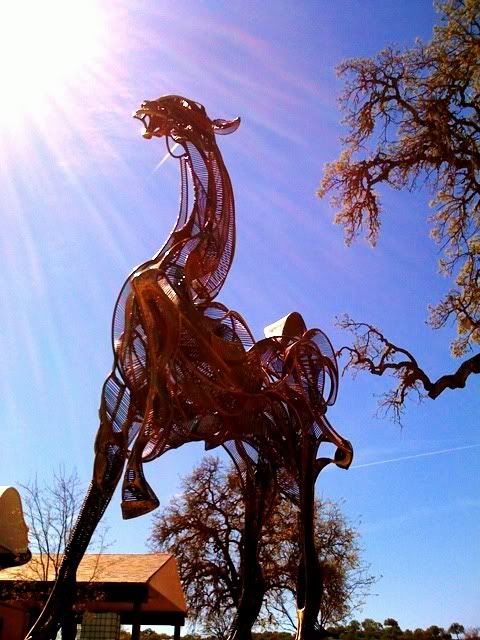
There is a long list of winery tasting rooms in Paso Robles which are fun to visit, but there's one you really have to see. Sculpterra Winery pours some good wine, but they also show off some dandy visual arts to go with it.
Sculpterra's property is adorned with beautiful iron work from master blacksmith Bob Bentley and the tasting room features contemporary art by Aleah Koury. The grounds around the tasting room are a real treat, with sculptures in bronze and granite by John Jagger.
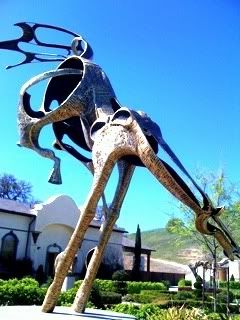 Pictures don't really do justice, so plan a visit to Sculpterra for your next trip to Paso Robles. You'll be glad you did. Just don't get so mesmerized outside that you forget to go inside to taste the wine.
Pictures don't really do justice, so plan a visit to Sculpterra for your next trip to Paso Robles. You'll be glad you did. Just don't get so mesmerized outside that you forget to go inside to taste the wine.
The Frankel family started out growing pistachios and a few grapes. The grapes won, as they now dominate their 260 acre estate vineyard. They're still nuts about their pistachios, though. Have some from the tasting bar.
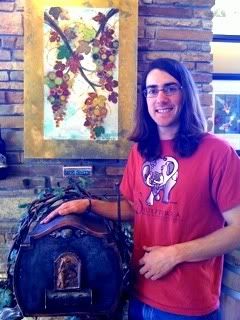 Young winemaker Paul Frankel is a 2009 grad of Cal Poly SLO. He has already shown his stuff in the winemaking game, sculpting some very nice wines to rival the sculptures outside the doors.
Young winemaker Paul Frankel is a 2009 grad of Cal Poly SLO. He has already shown his stuff in the winemaking game, sculpting some very nice wines to rival the sculptures outside the doors.
Sculpterra's 2010 Chardonnay is a steely white, while the 2009 Viognier has a big, floral nose with flavors of pears and honey.
The 2007 Merlot shows beautiful, smokey, red fruit, while their '07 Zinfandel is actually Primitivo. Great spices abound in the '07 Syrah from O'Neal Vineyard.
 The Sculpterra Cabs are wonderful. The '07 has a zin-like nose and evidence of the American and Hungarian oak. The '05 Cabernet Sauvigon - a library wine - is silky smooth with gentle tannins and a pencil point edge. The '06 Cab is much fruitier than the '05, and gives some nice minty, herbal notes.
The Sculpterra Cabs are wonderful. The '07 has a zin-like nose and evidence of the American and Hungarian oak. The '05 Cabernet Sauvigon - a library wine - is silky smooth with gentle tannins and a pencil point edge. The '06 Cab is much fruitier than the '05, and gives some nice minty, herbal notes.
The 2007 Figurine is Paul's initial stab at winemaking, and he really nailed it. Equal parts Cab and Zin with a bit of Merlot, this wine lets the different varieties really shine. The '07 Maquette shows a lot of graphite. It's 63% Cabernet Sauvignon, 25% Merlot and 12% Petite Sirah.
They also poured the dense '08 Petite Sirah and a non-vintage Zinfandel dessert wine. The late-harvest Zin is a Port-style wine with brilliant flavors that cry out for some blue cheese.
Follow Randy Fuller on Twitter.
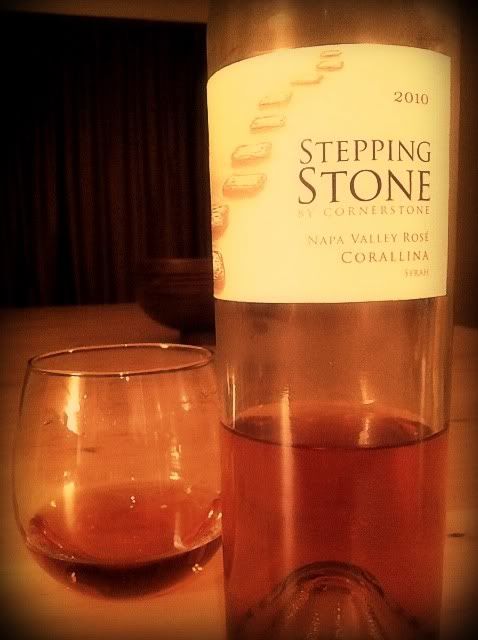
We have tasted and written about the Stepping Stone Riesling and Sauvignon Blanc Cuvée Musqué from Napa Valley's Cornerstone Cellars. Both are great wines for warm weather sipping. The winery also provided their rosé for our perusal.
Winemaker Jeff Keene did a fine job on the two under-$20-whites we tried, and his efforts with the pink produced similar results.
The Stepping Stone Corallina Rosé is made of Napa Valley Syrah, carries a very moderate 13.9% abv number and retails for $18. Cornerstone says the name "Corallina" is Italian for "coral," which is a pretty fair description of the color of this wine.
A beautiful nose of strawberry fruit and Pez candy sails along on an herbal undercurrent. There's no cloying sweetness here, not even close. It's bone dry with a zing of acidity right off the bat. The slightest trace of white pepper gives way to a beautiful layer of cherry and strawberry flavors overlayed with minerals. This wine will be welcome on the deck all summer, and on the lunch table any time of year.
Follow Randy Fuller on Twitter.

Wine aficionados always want to be on the leading edge of wine trends. At the London International Wine Fair, held in May, wine experts identified and explored trends in the wine world they felt were worthy of inspection.
An article in The Independent cites a trend toward wines with citrus - specifically lime - aromatics as one of the next big things these wine experts were expecting. Surprising blends and a deep and abiding love of Pinot Grigio were also singled out as major directions in the wine world.
A spokesperson for the event said the Austrian Rotgipfler is one grape those in the know are keeping in their sights, as well as the South African wine called Zevenwacht. That's a blend of Sauvignon Blanc, Viognier and Chardonnay.
The lime and citrus notes of Riesling and Gewurztraminer are said to be winning over wine drinkers everywhere, as is the Italian bubbly Prosecco. According to the spokesperson, many people find Prosecco's lighter approach preferable to the drier, heavier feel of Champagne.
The event spokesperson claimed that people seem to be "moving away from pure fruit... towards more restrained, elegant characteristics."
Follow Randy Fuller on Twitter.

One of Temecula’s showcase wineries - South Coast Winery - held their second live-streamed Group Therapy session of 2011 on May 25th. Interested parties watched the live video stream and tweeted with one another - and the world - about the wines they were tasting.
The event is designed to coincide with their wine club shipments, so you can expect another Group Therapy session sometime in August. Tasters were able to order ahead of time the package of wines being featured so they could taste and tweet along with everyone else. Now And Zin was provided with complimentary samples for review.
With one event like this already under their belts, the group at South Coast Winery seemed pretty relaxed in their comfy chairs in front of a cozy fireplace. South Coast Owner Jim Carter and winemakers Jon McPherson and Javier Flores held the fireside chat in a living room setting with the logs burning behind them. Carter used the homey setting to announce that the South Coast wines will soon be distributed nationally.
The participants on the viewing end had a nice time, too. In addition to those tasting in person, there were wine lovers chatting on the winery’s website and on Twitter about the four wines in the tasting group. I caught several comments indicating pleasant surprise at the quality of the wines as well as at least one complaining of overly ripe fruit. That’s a matter for debate; while the flavors were admittedly big, I didn’t feel it was something unexpected from grapes grown in Southern California.
Here are the wines which were tasted in the most recent Group Therapy session:
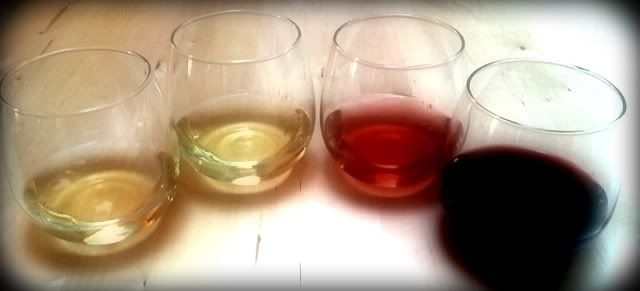 South Coast Winery Sauvignon Blanc Musqué Clone 2009
South Coast Winery Sauvignon Blanc Musqué Clone 2009
Temecula Valley Carter Estate Vineyard
This extremely aromatic wine is made entirely of the Musqué clone of Sauvignon Blanc. That’s a cross between Sauvignon Blanc and Muscat. This clone allows the florality of Muscat to soften the acute grassiness of Sauvignon Blanc. The Carter Estate Vineyard, from which the grapes come, is now seven years old. The wine has an amazingly low alcohol level of 12.2% abv.
Light in color and beautifully aromatic, the wine has generous notes of fresh cut grass and a driveway after a brief rain. The mouthfeel comes on strong, too. There’s a striking acidity, with flavors of lemon peel and minerals.
South Coast Winery Brut 2007
Temecula Valley Sparkling Wine
70% Chardonnay and 30% Pinot Noir, this sparkler shows off its main grape. Most of the fermentation was in stainless steel, while only 12% of the blend was fermented in new French oak. Closed cuve secondary fermentation with 11 months on the lees finished this methode champenoise offering. The alcohol level is 13% abv.
Despite the limited exposure to oak, there's a very aromatic nose with huge yeasty notes. Flavors of apples and citrus dominate the palate, and there is quite a bit of acidity. It's a very fizzy wine, but when the bubbles die down it takes on the feel of a dry still wine with a touch of yeastiness. Several tasters were pining for some sushi to pair with it.
South Coast Winery Tempranillo Rosé 2010
Temecula Valley Carter Estate Vineyard
This Temecula Tempranillo is a beautiful light magenta color. The nose is, once again, aromatic. Strawberries are met with a touch of funk, while herbal berry aromas also come into play. The wine offers a zippy acidity, and the strawberry and cherry flavors are enormous!
South Coast Winery Syrah 2005
Temecula Valley Rolling Hills Estate Vineyard
This Syrah was fermented in stainless steel and aged 14 months in French/American hybrid barrels. The 14.3% abv alcohol level makes itself known on the nose, which is all spices, vanilla and clove layering over the blackberry and cassis fruit. Definitely not a cool climate Syrah, there's a ton of very ripe and juicy aromas with lots of spice and a touch of tar.
The palate shows intense fruit with big spice flavors as well. There's a lot of influence from the oak at first and it runs a bit hot, so let it sit a while or decant before serving. The wine shows a great meatiness after it opens up a bit. Three days after opening the nose is incredible. Tar, leather, meat and sage all play with an admirable complexity.
Follow Randy Fuller on Twitter.

The heat’s killing me. Just the short walk down to that crummy wine bar in Hollywood has soaked my shirt through. It's not a good look for a pool boy, much less a hard-boiled insurance man. Sometimes it's hard to to tell us apart.
I remember when I could walk down the street and get liquor. I could get liquored up, if I wanted. Now, wine bars all over Hollywood. Even in Los Feliz. One good thing about wine bars: you'll always find plenty of slick dames hanging around in them. None like her, though. None like Phyllis Dietrichson. Nobody can touch her, or that honey of an anklet she wore. Well, almost nobody.
Something was hinky about that Los Feliz iced tea she gave me. I asked if she had a bottle of beer that wasn't working, but I guess they were all busy. At my place, I thought she should have had some of that pink wine. The kind that bubbles. All I had was bourbon. Bourbon was enough for Phyllis.
The room started spinning and I dreamed I slipped out of character and headed up to MacMurray Ranch. It's in the Russian River Valley, prettiest place you ever saw. I bought it in '41, as a getaway from troubles just like this. After I'm done here, they'll probably sell the cattle and plant grapes. Maybe avocados. No, grapes. The better for making wine. Wine, to sell in wine bars to an everyman like me, Walter Neff. Wine, to be lifted as a toast to a slick dame like Phyllis. A slick dame like Phyllis who can have her way with a guy like Walter Neff.
How could I have known what kind of poison she was? How could I have known that anklet she wore was like a sign saying "Bad dog - keep away?" How could I have known wine bars would ever become so popular? How could I have known something so sweet, rich and powerful could go so bad?
How could I have known that murder can sometimes smell like honeysuckle?
Blood Of The Vines suggests pairing "Double Indemnity" with the 2009 MacMurray Ranch Pinot Noir, Russian River Valley. It features earthy cherry flavors - rich, sweet and powerful. It retails for $35.
Follow Randy Fuller on Twitter.

Yesterday we tasted the Stepping Stone Napa Valley Riesling. Napa Valley's Cornerstone Cellars also provided Now And Zin with the Sauvignon Blanc from their affordable Stepping Stone line. It's a Musqué clone, it's a great summertime wine and it retails for $18.
This racy white wine is made from a clone of Sauvignon Blanc called Cuveé Musqué, a highly aromatic version of Sauvignon Blanc crossed with the Muscat grape.
Stepping Stone's Musqué has an alcohol level of 13.5% abv. It's very pale in the glass, a very clean appearance with almost no color at all.
The nose is quite aromatic, musqué, if you will. The aromas of grassiness are most pronounced, but they stop short of some of the cruder descriptions people tend to use for Sauvignon Blanc at its most expressive. A strong citrus scent is also present, grapefruit to my nose.
The palate is full of minerals - wet rocks - and a bracing acidity that is most refreshing. There’s a citrus streak a mile wide, bountiful with limes and grapefruit. A zestiness on the finish leaves a crisp, clean feeling and the traces of minerals persist a long while.
We still have the Stepping Stone dry rosé to try, which we will do next week on Now And Zin.
Follow Randy Fuller on Twitter.
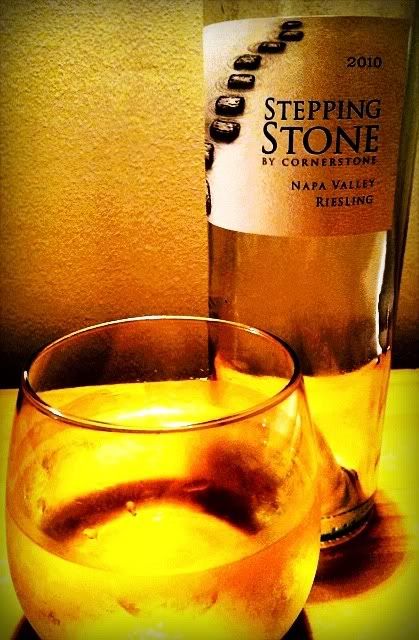
Napa Valley’s Cornerstone Cellars is known for their high-end Cabernet Sauvignon wines. These are wines mainly destined for the cellar, to be aged and enjoyed at some future date. We all want a wine to drink right now, though - with dinner tonight - and to that end, Cornerstone produces a line of everyday wines, made and priced to be enjoyed as soon you get them home. They carry the Stepping Stone label.
Cornerstone was kind enough to provide me with three of their Stepping Stone wines for review, two whites and a rosé. The trio retail for $18 each. Stepping Stone also offers a Syrah, Cabernet Franc and Cabernet Sauvignon. Today we'll find out about the Stepping Stone Napa Valley Riesling.
Winemaker Jeff Keene has done a great job with this Riesling, made the Alsatian style. The wine carries an alcohol level of 13.5% abv and has a pale, straw color.
The Stepping Stone Riesling's nose is simply beautiful. Soft aromas of flowers and honeydew are met with an equally soft sense of minerals for a bouquet with all the sharp edges removed. So gentle are the aromas I was somewhat surprised to find that the wine is fermented and aged completely in stainless steel. Despite the label designation, the grapes actually come from the cool-climate Carneros AVA.
The palate shows lovely citrus flavors - lime and some orange zest - and a fine minerality that rides on an acidity which would be just fine with a piece of fish, crackers and a soft cheese or even a handful of walnuts. It's a dry, crisp expression of Riesling and the finish is of medium length and really lets the acidity shine.
We'll cover the Stepping Stone Sauvignon Blanc Cuvée Musqué and their dry rosé tomorrow and next week on Now And Zin.
Follow Randy Fuller on Twitter.

The British royal family has certainly consumed enough sparkling wine - now they plan to make their own. TheTelegraph reports that the Duke of Edinburgh, Prince Phillip, is closely involved in a project to plant new vines of Pinot Noir, Chardonnay and Pinot Meunier in a section of Windsor Great Park. The intention is to produce a royal sparkling wine.
The English wine industry is looking at this development as a huge boon. According to the article, English wine had a banner year in 2010 with more than four million bottles of wine produced in England.
Master of Wine and viticultural consultant Stephen Skelton is also involved in the project, according to the Telegraph. He planted the first vines at Chapel Downs in 1976. Chapel Downs is now Britain's biggest wine producer.
Vineyards require three years to produce wine grapes, so there will be a wait for the royal vintages to start rolling out. The Telegraph observes that many hope it will be a royal sparkling wine which is hoisted in toasts at the next royal wedding.
Follow Randy Fuller on Twitter.
Still striving to taste 50 wines in 50 states, Now And Zin's Wine Country series gambles on a Zin from Nevada.
Nevada's wine industry is one of the tiniest in America. There are only three wineries in the state and a half dozen additional vineyards. At one time not too long ago, there was only one winery in Nevada, and it was the Pahrump Valley Winery, about an hour outside of Las Vegas.
Wine grapes are very hard to grow in Nevada, as the weather is not hospitable. Depending upon where you are, it's either too hot or too cold. The University of Nevada at Reno studies grape growing in an effort to stimulate that industry for the state. They feel the grape-growing areas in Washington and Colorado are similar in climate to the northern part of Nevada.
Pahrump Valley Winery is in the southern part of the state, where temperatures are very hot throughout the long summer and can get quite cold during the winter.
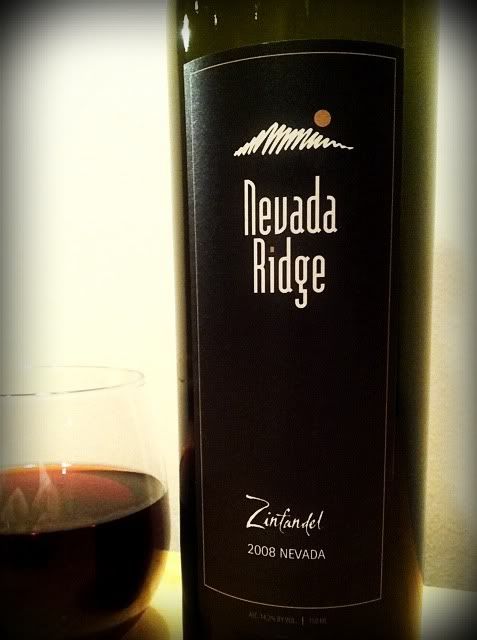 Pahrump Valley Winery was established in 1990 in the town that bills itself as "The Heart of the New Old West." Besides the winery, Pahrump is probably most noted for its legal brothels. Pahrump Valley's 2005 Nevada Ridge Zinfandel was the first Nevada-grown red wine produced in the state. They made 100 cases of that vintage and plan to produce 1200+ cases of wine in 2011. They also have the first-ever Nevada Port aging presently.
Pahrump Valley Winery was established in 1990 in the town that bills itself as "The Heart of the New Old West." Besides the winery, Pahrump is probably most noted for its legal brothels. Pahrump Valley's 2005 Nevada Ridge Zinfandel was the first Nevada-grown red wine produced in the state. They made 100 cases of that vintage and plan to produce 1200+ cases of wine in 2011. They also have the first-ever Nevada Port aging presently.
Pahrump Valley does utilize some California and Oregon grapes, but the Zinfandel is all Nevada and they proudly say it represents their terroir well.
Bill and Gretchen Loken - the winemakers and proprietors - give special thanks on the label of the ‘08 Nevada Ridge Zin to Jerry Nelson and Bob and Roni Regan, who are listed as contributing growers.
The Nevada Ridge 2008 Zinfandel is a medium ruby color I can see through. Wild cherry on the nose is joined by plenty of vanilla spice notes. There is quite a bit of alcohol on the nose, and on the palate at first. That’s surprising since it carries a 14.2% abv number, not huge by Zinfandel standards. The heat does settle down nicely after a bit of time, though. I’d recommend decanting for a couple of hours.
The wine shows big, bright berry flavors; there’s a raspberry layer over the wild cherry I smell, and a dusty aspect laces the fruit. A flavor of black tea lasts into the finish very pleasantly. It’s a fairly lengthy finish, too.
The mouthfeel is a little lighter than I am used to with California Zinfandels, but in the hot desert summertime, that’s probably a welcome attraction. I can even see drinking the Nevada Ridge Zin with a bit of a chill on it - say, at a barbecue.
Follow Randy Fuller on Twitter

Wine Goes To The Movies
with NowAndZin.com and TrailersFromHell.com
Pairing wine with certain movies requires a leap of faith. How would you really feel having fava beans and Chianti while watching "Silence Of The Lambs?" "Arsenic And Old Lace" presents a similar difficulty.
Frank Capra's film rendition of "Arsenic And Old Lace" stars Cary Grant as a newlywed who discovers his two sweet, old aunts are inviting elderly men to their home and offering them elderberry wine dosed with poison.
They do this as a sort of public service. They figure the old guys had nothing to live for and they give them a little push toward everlasting peace. So, two sweet, little old ladies are revealed to be murderers. Sweet, little, old murderers, but murderers nonetheless. It’s a dark comedy with plenty of laughs.
While noodling around on the internet - we call that "research" - I found an interesting wine factoid about Cary Grant. Supposedly, Grant once beat Winston Churchill in a wine tasting contest! The score was evened later when Churchill beat Grant at cigar tasting. Is it true? Who knows? It was on the internet. But I like to think it is.
You can pick your poison for "Arsenic And Old Lace," but how could you resist pairing it with elderberry wine? Manischewitz offers an elderberry wine that's easy to find and keeps the cost of date night down - it's less than $5 a bottle. It's a very sweet wine, just like those little old ladies.
The trouble is, it's not really elderberry wine. It's made from grapes with some flavoring added. Not so bad, considering what's being added to the wine in the movie.
You can make your own elderberry wine, or have someone you really trust make it for you. Just don't use the recipe given in the movie, which calls for "one teaspoon full of arsenic, half a teaspoon full of strychnine, and then just a pinch of cyanide."
Whatever wine you choose for "Arsenic And Old Lace," we recommend opening the bottle and pouring in plain view of all present. We want the only "funny stuff" to be that which is in the movie.
See this article and a lot more cool movie stuff on the Trailers From Hell blog, From Hell It Came.

American wine drinkers sometimes find wines from other countries a little hard to navigate. The labels are written in languages you may not understand, using terminology you may not be familiar with even if you speak the language. That's why it's a good idea to pursue opportunities to expand your knowledge of wine the world over.
Los Angeles was treated to the Drink Ribera Workshop recently. The event spotlighted the wines of the Spanish wine region Ribera del Duero on May 2, 2011 at SLS Hotel at Beverly Hills. There were not an extraordinary number of wineries - bodegas - represented, but the turnout was good and the tasters seemed to enjoy the wines quite a bit.
Immersing yourself in the wines of other countries at events like Drink Ribera is the best way I know to become more familiar with these wines and expand your knowledge base.
The event had one facet which I have not noticed at other wine shows presenting wines from other countries in America. In addition to the tables for each winery that already has representation in the U.S., there was a large table with bottles from wineries seekingrepresentation. There were some importers tasting and discussing the wines, and I hope some struggling Ribera winemakers end up with American distribution as a result.
Ribera del Duero is located in Spain’s northern plateau, about an hour and a half from Madrid. The region is about 71 miles long and 22 miles wide and covers four provinces of Castilla y León - Burgos, Segovia, Soria and Valladolid. Ribera - meaning "river bank" - lies along the Duero River Valley. Ribera benefits from the great diversity of the soils on both banks of the river.
The average altitude of the vineyards in Ribera is 2750 feet, with some at over 3000 feet above sea level. The area has dry summers in which temperatures can reach over 100 degrees Fahrenheit and long harsh winters that can send the temperature down to below zero. Ribera only gets an average of 17 inches of rain per year. Winemaking in Ribera dates back 2,000 years.
The short growing season of Ribera del Duero, combined with the diverse soils and modest rainfall make Ribera a good place to make wine of rich intensity. Ribera's main grape - Tempranillo - is an early ripening grape well suited for the conditions there.
Wines produced in Ribera del Duero fall under several designations:
Joven - No oak is used in producing Jovan wines, which are typically fruity and intended for immediate consumption.
Crianza - These are aged for two years with a minimum of twelve months in oak barrels.
Reserva - Aged three years with a minimum of twelve months in oak barrels.
Gran Reserva - These wines are made in select vintage years only. They are aged a minimum of five years with twenty-four months in oak barrels minimum followed by additional bottle aging.
Rosado - Rosé wines are fermented without the skin of the grape and are available shortly after the harvest.
Here are five favorites I sampled at the Drink Ribera Workshop:
Bodega San Roque de la Encina
Monte Pinadillo Crianza 2007 - Imported by Luxe Vintages, this is a very dry Tempranillo, loaded with spices and big fruit flavors.
Bodegas y Vinedos Ortega Fournier, S.L.
Alpha Spiga 2004 - Distributed by Henry Wine Group, the grapes for this wine were taken from 70-year-old vines. It has received 90+ ratings from critics.
Protos Bodega Ribera Duero de Penafiel, S.L.
Reserva 2005 - Imported by Winebow, this is a star of their lineup. It's easy to taste why, with a candy-like nose and palate.
Vega Real
Crianza 2007 - Imported by New Age Imports, there are tons of spices in this one.
Vina Gourmaz
Tempranillo 2009 - Imported by Classical Wines from Spain, this was my favorite. Beautiful blackberry and raspberry flavors dominate.
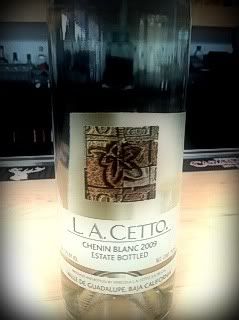
Southern California wine adventurers who would like to take a Mexican wine for a spin can do so at the Loteria Grill Studio City location. Loteria Grill is known for their incredible Mexican food, so it seems a natural for them to offer wines made in Mexico to pair with their cuisine.
L.A. Cetto, I'm told, is a mass producer of wine south of the border - along the lines of Gallo in the U.S. While their wines aren't thought to be reflective of the burgeoning quality wine industry in Mexico, they are popular and relatively easy to find.
The Chenin Blanc from L.A. Cetto is made from 100% Chenin Blanc grapes grown in the Valle de Guadalupe region of Baja California. The wine has an alcohol level of 12% and sells for around $10 a bottle. It was $9 by the glass at Loteria.
Almost clear in the glass, the wine has a fresh nose with minerals and pears leading the way. It tastes very fresh and light with a mild acidity that makes a better show on the finish. Tropical notes come on the mid-palate, which helps it pair so well with the plantains. It would seem to be made for that match. It's a lesser success with the cheese enchilada in a pumpkin seed sauce, but that sauce is not to be missed.

A new report seems to surface weekly on further findings of the health benefits of wine. Wine has been reported to reduce the risk of stroke, heart disease, cancer, clogged arteries, kidney stones, dementia - it has even been credited with prolonging life itself.
We know for sure it makes life more enjoyable, but now, according to an article in Wine Spectator, wine may help reduce bone loss in men over 50 years of age.
An Australian study found a correlation between red wine consumption and improved bone mineral density in men over 50. Keeping your bone density high helps stave off osteoporosis. The article cites the Surgeon General's figure of 44 million Americans who have osteoporosis and his prediction that half of the 50-plus set will have weak bones within ten years.
The researchers figure it may well be the contents of the grape skins which are beneficial to bone strength, and they also noted the possibility that silicon in beer could be a contributing factor.
At any rate, the scientists say a lot more research will be needed, and the head of the team said he wasn't in short supply of volunteers.
Be careful how much red wine you consume to keep your bones strong. Over-indulging in alcoholic beverages contributes to a higher rate of bone fractures in older people.

If you feel like a trip to California's Central Coast wine region, and you like Chardonnay - here's an event you should try to attend. The Chardonnay Symposium, July 23rd in bucolic Santa Maria, California.
The Chardonnay Symposium is a full day devoted to the Chardonnay grape and the wines made from it.
Two educational panels kick off the festivities - one at the famous Bien Nacido Vineyard and the other atTantara Winery. They're followed by a luncheon at Au Bon Climat Winery and then a Chardonnay Grand Tasting event at Byron Vineyard and Winery, where you'll taste delightful examples of Chardonnay from Oregon, Sonoma and the California Central Coast.
Guest speakers include Wine Enthusiast writer Steve Heimoff and wine expert Karen MacNeil, author of The Wine Bible.
For Chardonnay lovers, this a "can't miss" event. Tickets cost $125 for the full day and $65 for the Grand Tasting event only.

Wine Goes To The Movies
with NowAndZin.com and TrailersFromHell.com
Thinking about wine and "The Godfather," the natural question is: What kind of wine would Don Corleone drink? With that question in mind, I turned to the one and only source for factual information - the internet.
I found that someone had already been curious about that topic, and had asked Yahoo Answers the very same question. There was a scant response - c'mon people, it's the internet! Have an opinion! - and a few choices were tossed out there, including Valpolicella, Chianti and Amarone. Good choices, but let's be sure before we view The Godfather.
Brando's Corleone does say in the movie that in his advancing years he likes drinking wine more than he used to. To which his son Michael replies "It's good for ya pop!"
The Don might like a Moscato out in the garden when he's sticking an orange peel in his mouth, but it's hard to imagine The Godfather as a white wine kind of guy.
The fact that Corleone is Sicilian might suggest we look to some of the wines for which that volcanic island is known. Dessert wine is a possibility. Sweet wines often pair well with their opposites, and The Don certainly seems to be the opposite of sweet. The Godfather might use Marsala to cook with, if he cooked, but he wouldn't drink it.
Chianti? He likes cannellini beans, not fava beans. Anyway, we're getting into a different movie.
Some have suggested to me that Corleone might enjoy a Barolo. That’s not a bad suggestion, but the Nebbiolo grape is primarily from the northern part of Italy, not Sicily. Also, Barolo is considered a strong and forceful wine. The Godfather might tend to look at anything with a jaundiced eye if he felt it might threaten his power and standing - especially if it was from another neighborhood.
Corleone would probably like a nice Nero d'Avola, a hearty red wine that's full-bodied - like the Don - and usually not blended, but allowed to stand on its own two feet, like a man. Corleone would love that stance, even though he preferred to have others dependent upon him.
The grape actually comes from Avola, which is on the other side of Sicily from the Don's birthplace of Corleone. Is there, however, a winemaker in Avola who would deny The Godfather a bottle of his finest?

Ventura County, once a Southern California stop-for-gas locale between Los Angeles and Santa Barbara, now has a great reason to stop and stay awhile - a wine trail of their own. The Ventura County Wine Trail is made up of 11 wineries calling Ventura County home plus four located in Malibu.
The area is a little too spread out to make for a convenient one-day excursion, but you can break it up into smaller segments and manage it a bit at a time.
The Malibu Section
Four wineries are in the Malibu and Malibu Hills area, up in the Santa Monica Mountains. Elevations of around 1,400 feet and cool ocean breezes make for some good grape-growing conditions.
Rosenthal Malibu Estate
In 1987 George Rosenthal planted the first grapes in this area since Prohibition and spearheaded the effort to get AVA status for Newton Canyon, which is contained in California's South Coast AVA. The winery's tasting room is actually down at sea level, on Pacific Coast Highway, with a great view of the beach.
Cornell Winery and Tasting Room
Cornell has its own wine to pour, but Tim Skogstrom also pours the wine of nearly two dozen other vintners in the Malibu Hills. It's a laid-back, history-laden place.
Cielo Malibu Estate Wineyards
Richard and Diana Hirsh founded Cielo in what was to become the Saddlerock Malibu AVA. Their '06 Syrah Blackcrow Mountain was a double gold award winner at the San Francisco International Wine Competition. The Cielo wines may be sampled at the SIP Malibu Tasting Room in Agoura.
Malibu Wines
Way up in the mountains right between the 101 Freeway and Pacific Coast Highway, Malibu Wines has two labels to offer. Semler is their estate label and Saddlerock is wine produced from grapes sourced elsewhere in the Central Coast.
The 101 Freeway Section
Four Brix Winery
Gary Stewart and the Four Brix Family source eleven different varities of grapes from nine vineyards in six appellations. Taste their wines at The Wineyard, home of their official tasting room in Thousand Oaks.
Los Robles Hills Winery
Also in Thousand Oaks, the Los Robles Hill vineyard is named Puerta del Cielo, which means "Gate of Heaven." It's an homage to the Spanish missionaries who traveled El Camino Real and planted a lot of grapes themselves.
Camarillo Custom Crush Winery
This a place where other vintners come to make their wines. The tasting room - open on weekends - features the wine of three local vineyards per week.
Bella Victorian Vineyard
A Victorian-style home with a vineyard in the backyard - it's a refreshing break from Southern California suburbia. The tasting room features a bistro, and the grounds are offered as a beautiful place for weddings.
Cantara Cellars
Cantara sources Northern California grapes from Lodi and pours their wines at the winery's tasting room in Camarillo.
Herzog Wine Cellars
Driven from their Slovakian home in 1948, the Herzog family moved to New York City, where they made wine until moving to California in 1985. Their winery was constructed some 20 years later in Oxnard. The tasting room is on-site, where you can try the Baron Herzog and Herzog Wine Cellars labels.
Magnavino Cellars
This Oxnard winery relies primarily on Lodi grapes. Their Viognier is sourced in Santa Barbara County.
Rancho Ventavo Cellars
Operating from an Oxnard avocado and lemon ranch, winemaker George Gilpatrick draws fruit from a variety of locales, including Paso Robles, Santa Barbara County and the Sierra Foothills. The tasting room is in downtown Oxnard.
The Ojai Section
Old Creek Ranch Winery
Wine production on the Old Creek Ranch in the Ojai Valley dates back to the 1800s. The original winery is still on the property, but the current version was founded in 1981. Old Creek Ranch is cattle ranch with fruit orchards, so the grapes are sourced from Napa Valley and a number of notable vineyards in Santa Barbara County. The tasting room overlooks the orchards. Feel free to bring a picnic lunch.
Casa Barranca
The Casa Barranca Estate is a national historic landmark featuring the 1909 California Craftsman Pratt House. The estate is unfortunately not open to the public, but the tasting room in downtown Ojai is. Their ICO certified organic vineyard produces Syrah, Grenache, Semillon and Viognier grapes.
Ojai Vineyard
Adam Tolmach produces excellent wines using grapes from Santa Barbara County - including the Sta. Rita Hills - and the Ojai Valley. The tasting room is located in downtown Ojai.
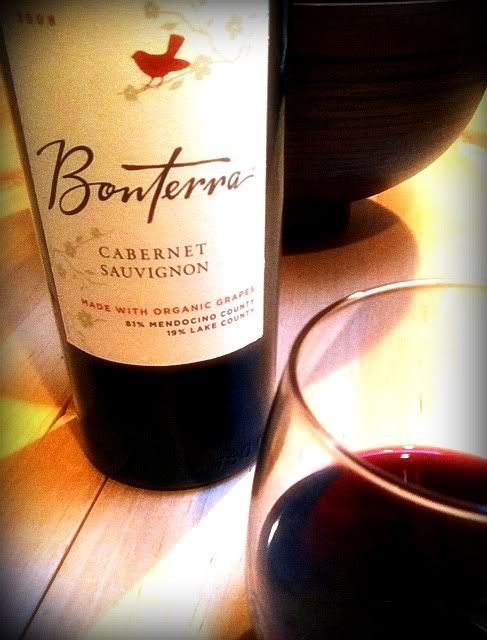
One of the nice things about being someone who is visibly interested in wine is the fact that friends and family never have to think too hard about what to give me on gift-giving occasions. Hint: it's a one-word answer.
My birthday triggered a very nice influx of bottles, so the wine rack at chez Now And Zin is full and happy. The first cork to pop from the birthday bounty was a very nice California Cabernet Sauvignon from Mendocino County.
Bonterra Winery is in Hopland, California. They farm organically, and have done so since 1987. All the fruit used in making this wine is organic; 81% of it comes from Mendocino County with 19% contributed by Lake County.
Winemaker Robert Blue states on the label his affinity for organic farming and his belief that it produces the highest quality grapes. Bonterra Winery and their grapes are certified by the California Certified Organic Farmers. That label on the bottle is even made from 100% post-consumer recycled product.
The Bonterra Cab carries a 13.5% abv number.
The Cabernet Sauvignon is blended with Merlot, Syrah and what Bonterra calls "other complementary varietals." I don’t know why they are so secretive about it, though. The wine is a medium-dark ruby color in the glass, and it offers a huge fruit expression on the nose. Cherries make the big play, with plenty of spiciness. I pick up the scent of white pepper and a layer of vanilla and cedar.
The alcohol shows too much in the first sip, about 15 minutes after the bottle was opened. Cherries, cherry cola and a raspberry note struggle to come forward through the haze.
Give it some time, and it settles down nicely. Eventually it becomes as smooth as silk. Over time, brambly notes and some graphite show up to augment the plum and blackberry flavors. Firm tannins are present even on the third night the bottle is open, and the black cherry cola finish stays a long time.
Bonterra has crafted a delicious wine that's downright affordable to buy - or to give as a gift.

There's another report citing health benefits of drinking wine. Wine Spectator magazine reports the results of a study conducted in southern and central Italy, in which it appears a lifetime of drinking red wine reduces the risk of developing essential tremor.
Essential tremor is the name for the uncontrollable shaking developed by some elderly people, which may be associated with Parkinson's disease.
The study shows that drinking four or five glasses of red wine per day for 30 years or so reduces the risk of tremors by 85%. Those who consumed three glasses a day over that same time frame showed a 65% lower risk.
While the study credits the antioxidants in red wine for the protection, it cautions that the results are not definitive. The sample was only 200 people, and 22 of them did develop essential tremor during the study. 19 of those fit the profile of the low-risk category.
The article quotes the authors of the study, "Case-control studies are generally prone to several kinds of bias. Larger ad-hoc studies are still needed to assess the role of alcohol drinking as a protective factor for developing essential tremor."
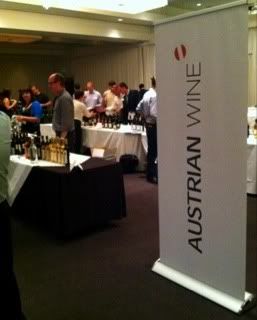
Austria Uncorked, a showing of Austrian wines at the SLS Hotel at Beverly Hills May 2nd, 2011, promised a bevy of fabulous white wines to sample - after all, highly structured whites are what Austria is best known for worldwide.
If Austria has a national grape, it would have to be Grüner Veltliner. The food-friendly, mineral-driven GruVee was all over the room at this event, with most tables pouring several versions. Riesling was popular, too. Chardonnay and Sauvignon Blanc also popped up from time to time. Riesling has a reputation as a sweet wine for some, but the Austrian expression of the grape is quite dry and sometimes so mineral-driven that the fruit is almost obscured.
Despite the grace and elegance shown by the white wines, it was the red wine from Austria which really shone. Blaufrankisch, Zweigelt and St. Laurent are grapes which are all well under the radar for American wine drinkers, unheralded - if not unknown - to most. Examples of Austrian Pinot Noir showed earthy minerality, light texture and low alcohol levels. In fact, I don't recall seeing many wines at Austria Uncorked with an alcohol level higher than 14%.
My favorite stop was the table where Birgit Braunstein presented her wines and those of her husband, Martin Pasler. Their vineyards were planted 70 years ago by her grandfather on land that's been in her family for hundreds of years. Several of their wines ended up as favorites of mine from this event.
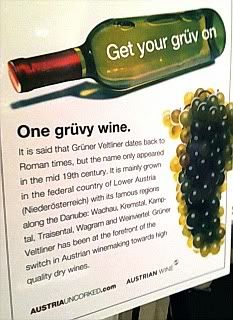 As is the case at wine tasting events where there is a proliferation of one particular type of wine, I experienced palate fatigue and the Gruner Veltliners all started to taste the same. I've experienced the same thing at events that were heavy on Pinot Noir, Tempranillo and Albarino. Mixing it up made for a good palate cleanser. I'd taste whites for a while, then reds, then back to whites. I even went across the property and sampled a few Ribera Tempranillos at another event going on at the same time. As good as those Spanish wines were, I didn't stay long. I couldn't wait to get back to Austria.
As is the case at wine tasting events where there is a proliferation of one particular type of wine, I experienced palate fatigue and the Gruner Veltliners all started to taste the same. I've experienced the same thing at events that were heavy on Pinot Noir, Tempranillo and Albarino. Mixing it up made for a good palate cleanser. I'd taste whites for a while, then reds, then back to whites. I even went across the property and sampled a few Ribera Tempranillos at another event going on at the same time. As good as those Spanish wines were, I didn't stay long. I couldn't wait to get back to Austria.
Austria is roughly at the same latitude as Burgundy, but with more dramatic temperature swings. Hot days and cool nights help produce wines with aromatic, full-bodied character. 35 grape varieties are authorized for use in making quality wine in Austria. About a third of the grapes are red wine, another third Gruner Veltliner. Field blends are common in Austria, where they are called gemischten Satz. These wines are blends in which the different grapes are harvested and vinified at once.
After the event, I retired to the SLS bar to go over my notes. Next to me was a young couple engaged in spirited discussion with Wolfgang Puck. They talked on a number of topics related to food and wine - I couldn't help overhearing - and it wasn't surprising to discover that Puck likes Austrian wines. He has a soft spot for the wines of Alsace as well.
It has occurred to me before - and was brought into sharp focus at Austria Uncorked - that red wines are more about taste while white wines are more about feeling. I'll close with a few of my favorite tastes and feelings of the event.
The event was staged by the Austrian Wine Marketing Board and the Austrian Trade Commission, and event was the featured event for Austria Wine Week LA, in which a handful of tastings were staged around SoCal.
The Wines
 As I mentioned earlier, the wines of Brigit Braunstein and Martin Pasler were my favorites. Their vineyards are in Burgenland, on Lake Neusiedl in the Neusiedlersee - Hugelland region. Braunstein took over her family's winegrowing business in the mid 1990s and produced her first vintage in 1996. She says it was "a moment of real happiness in my life." Her appearance at Austria Uncorked constituted her first visit to the U.S.
As I mentioned earlier, the wines of Brigit Braunstein and Martin Pasler were my favorites. Their vineyards are in Burgenland, on Lake Neusiedl in the Neusiedlersee - Hugelland region. Braunstein took over her family's winegrowing business in the mid 1990s and produced her first vintage in 1996. She says it was "a moment of real happiness in my life." Her appearance at Austria Uncorked constituted her first visit to the U.S.
Braunstein poured two white wines of note, a Welschriesling and a Weissburgunder. Welschriesling has no relation to the Riesling grape and is of unclear origin. Weissburgunder is better known as Pinot Blanc. The former has a lovely, aromatic nose sporting green peppers and flowers, while the latter has a creamy, fruity taste of peaches and pears. Both these whites feature great acidity, but that was not an uncommon tasting note throughout the room.
Braunstein's reds really bowled me over. Her Zweigelt - the most-planted red grape in Austria - has a beautiful cherry nose and a huge cherry taste. The Blaufrankisch shows its chalky, limestone soil with an earthy nose and mineral-laced strawberries on the palate. The St. Laurent - a grape which is a child of Pinot Noir bearing the same cantankerous traits as its parent - is a complete delight. Her Oxhoft red blend marries Blaufrankisch, Zweigelt and Cabernet Sauvignon for a wine which displays enormous red fruit on the nose and on the brilliant palate.
As if these treats were not enough, we proceeded to the dessert wines. A pair of Botrytis-infected beauties were poured. The Beerenauslese blends Welschriesling for acidity, Goldburgerfor the fruit and Neuburger for the sweetness. Sweet pears and apricots show in this delicious dessert wine. The Trockenbeerenauslese is a late harvest Pinot Noir showing the chalky limestone soil in its sultry sugar.
More Wines
Judith Beck - '09 Zweigelt shows extreme earthiness and brilliant fruit flavors at once.
J. Heinrich Winery - '08 Cuvee of Blaufrankisch, Cabernet Sauvignon and Merlot presents a very smokey nose and spicy red fruit.
Juris Winery - '08 St. Laurent has a dirty, funky nose, and I mean that in a great way. Tart and dry, very interesting.
Rosenhof Winery - Four dessert wines - Beerenauslese, two Trockenbeerenauslese and Eiswein - that are sweet with great acidity.
Johanneshof Reinisch Winery - A 2010 Rotgipfler - have you had that grape? - is a white with a nutty salinity and citrus fruit. Also, an $89 '06 St. Laurent which has tannins as smooth as silk.
Salomon Unhof Winery - A 2009 Gruner Veltliner Reserve from the Lindberg Vineyard is creamy and full with a citrus finish.
Turk Winery - A 2009 Gruner Veltliner from the Kremser Sandgrube Vineyard has great acidity and a spicy citrus zest taste.
R & A Pfaffl Wine Estate - A no-oak 2010 Zweigelt with bright cherry nose and flavors would be great chilled on the deck this summer. Their '08 St. Laurent shows fantastic minerals on the nose and a dry, dark cherry taste.
Kracher Winery - They poured six dessert wines. Tops were the '08 Cuvee of Welshriesling and Chardonnay - done in steel, but showing a smokey sweetness - and the '08 ScheurebeTrockenbeerenauslese which is viscous, sweet and clean.
I enjoyed stopping at each table at Austria Uncorked, and limiting myself to just these wines I've mentioned seems an injustice. There were so many great tasting Blaufrankisch, Zeigelt and St. Laurent wines - not to mention all the Gruner Veltliners and Rieslings - that this piece could have gone on for pages and pages. If you are not familiar with Austrian wines, get familiar. You'll be doing yourself and your palate a favor.


 Pictures don't really do justice, so plan a visit to Sculpterra for your next trip to Paso Robles. You'll be glad you did. Just don't get so mesmerized outside that you forget to go inside to taste the wine.
Pictures don't really do justice, so plan a visit to Sculpterra for your next trip to Paso Robles. You'll be glad you did. Just don't get so mesmerized outside that you forget to go inside to taste the wine. Young winemaker Paul Frankel is a 2009 grad of Cal Poly SLO. He has already shown his stuff in the winemaking game, sculpting some very nice wines to rival the sculptures outside the doors.
Young winemaker Paul Frankel is a 2009 grad of Cal Poly SLO. He has already shown his stuff in the winemaking game, sculpting some very nice wines to rival the sculptures outside the doors. The Sculpterra Cabs are wonderful. The '07 has a zin-like nose and evidence of the American and Hungarian oak. The '05 Cabernet Sauvigon - a library wine - is silky smooth with gentle tannins and a pencil point edge. The '06 Cab is much fruitier than the '05, and gives some nice minty, herbal notes.
The Sculpterra Cabs are wonderful. The '07 has a zin-like nose and evidence of the American and Hungarian oak. The '05 Cabernet Sauvigon - a library wine - is silky smooth with gentle tannins and a pencil point edge. The '06 Cab is much fruitier than the '05, and gives some nice minty, herbal notes.


 South Coast Winery Sauvignon Blanc Musqué Clone 2009
South Coast Winery Sauvignon Blanc Musqué Clone 2009 



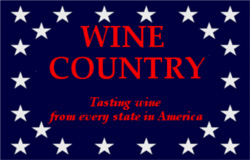
 Pahrump Valley Winery was established in 1990 in the town that bills itself as "The Heart of the New Old West." Besides the winery, Pahrump is probably most noted for its legal brothels. Pahrump Valley's 2005 Nevada Ridge Zinfandel was the first Nevada-grown red wine produced in the state. They made 100 cases of that vintage and plan to produce 1200+ cases of wine in 2011. They also have the first-ever Nevada Port aging presently.
Pahrump Valley Winery was established in 1990 in the town that bills itself as "The Heart of the New Old West." Besides the winery, Pahrump is probably most noted for its legal brothels. Pahrump Valley's 2005 Nevada Ridge Zinfandel was the first Nevada-grown red wine produced in the state. They made 100 cases of that vintage and plan to produce 1200+ cases of wine in 2011. They also have the first-ever Nevada Port aging presently.









 As is the case at wine tasting events where there is a proliferation of one particular type of wine, I experienced palate fatigue and the Gruner Veltliners all started to taste the same. I've experienced the same thing at events that were heavy on Pinot Noir, Tempranillo and Albarino. Mixing it up made for a good palate cleanser. I'd taste whites for a while, then reds, then back to whites. I even went across the property and sampled a few Ribera Tempranillos at another event going on at the same time. As good as those Spanish wines were, I didn't stay long. I couldn't wait to get back to Austria.
As is the case at wine tasting events where there is a proliferation of one particular type of wine, I experienced palate fatigue and the Gruner Veltliners all started to taste the same. I've experienced the same thing at events that were heavy on Pinot Noir, Tempranillo and Albarino. Mixing it up made for a good palate cleanser. I'd taste whites for a while, then reds, then back to whites. I even went across the property and sampled a few Ribera Tempranillos at another event going on at the same time. As good as those Spanish wines were, I didn't stay long. I couldn't wait to get back to Austria. As I mentioned earlier, the wines of
As I mentioned earlier, the wines of